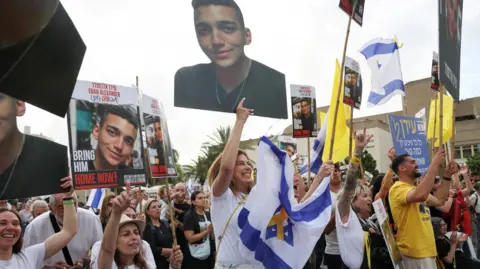On May 12, 2025, Edan Alexander, a 21-year-old Israeli-American, was released by the Palestinian militant group Hamas after being held captive for 19 months. His release was part of ongoing negotiations aimed at securing a new ceasefire agreement amidst the ongoing conflict between Israel and Hamas, as announced by the militant group. Mr. Alexander had been serving in the Israeli army along the Gaza border when he was captured during a violent escalation on October 7, 2023—a day that marked a significant turning point in the Israel-Gaza conflict.
The release came after Israel temporarily halted its military operations in Gaza, allowing for the transfer of the young soldier. A senior official from Hamas indicated that this action was intended as a goodwill gesture prior to U.S. President Donald Trump’s visit to the Middle East scheduled for May 13, 2025. As one of the last known U.S. citizens in Hamas’s custody, Mr. Alexander’s liberation was met with relief and celebration. President Trump publicly congratulated his family, emphasizing the importance of diplomatic efforts in securing his release.
The family of Edan Alexander expressed gratitude to Donald Trump for his role but also called on the Israeli government and their negotiators to continue their efforts in liberating the remaining 58 hostages still held by Hamas. This indicated an understanding of the complexity of the situation and a concern for fellow hostages yet to be freed.
Following his release, Edan was seen in the southern Gaza city of Khan Younis, accompanied by masked Hamas fighters who handed him over to representatives from the Red Cross. Once safely in their custody, he was then transferred to Israeli officials, culminating in a reunion with his family in southern Israel. The military operation to ensure a safe passage emphasized the delicate negotiations involved in such a high-stakes exchange and the presence of a “safe corridor” for the transfer.
Visuals shared through social media by Israeli Prime Minister Benjamin Netanyahu captured an emotional moment when Edan’s mother, Yael Alexander, conveyed her feelings to him over the phone, assuring him that he was strong, protected, and back home. Netanyahu described the moment as “very moving” and expressed his appreciation for the American support that had facilitated this release.
Nevertheless, the backdrop of this release is steeped in ongoing military tensions. Since March 2025, Israel has reinstituted its military campaign against Hamas, which had paused for a two-month ceasefire ending in mid-March. The military’s action, according to Netanyahu, created enough pressure for Hamas to agree to the release, thus illustrating the intertwining of military power and diplomatic negotiations in high-stakes situations like hostage releases.
In a broader context, Hamas had indicated that Mr. Alexander’s release was aimed at opening negotiations for humanitarian aid into the Gaza Strip, which had faced extreme restrictions over the past 70 days, drawing severe criticism from international humanitarian organizations.
The capture of Edan Alexander occurred during a brutal escalation in violence on October 7, 2023, when a reported 1,200 individuals were killed, and numerous hostages were taken by Hamas. As of now, it is estimated that up to 58 hostages remain in captivity, with various reports indicating they may include several Americans. Understanding the humanitarian dimensions of this conflict is crucial, as continued military and political actions may lead to unforeseen consequences.
As discussions regarding humanitarian aid proceed, the political dynamics intensify. Israeli officials plan to meet representatives from Qatar as part of efforts to discuss potential further hostage releases. The involvement of external entities like Qatar and Egypt underscores the multifaceted nature of international diplomacy in the ongoing conflict, adding a layer of complexity to the situation.
Ultimately, Edan Alexander’s story does not just reflect personal hardship; it embodies the larger narrative of a conflict that continues to evolve, complicating both the humanitarian landscape and the political negotiations that follow. While there may be signs of potential truce discussions following his release, the broader implications of military strategies juxtaposed with humanitarian needs cannot be overlooked.



